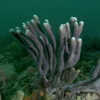General Description
A dark purple to brown sponge species, flabelliform to branching. Size of about 30 cm.
Habitat
Reef areas, to depth of 25 m.
Sponge gardens
Reefs
Distribution guide
Port Phillip in Victoria.
Species Group
Depth
Water Column
Max Size
30 cm
Diet
Plankton or particles
Commercial Species
No
Global Dispersal
Recorded in Australia
Species Code
sp. MoV 6718
Identify
Conservation Status
- DSE Advisory List : Not listed
- EPBC Act 1999 : Not listed
- IUCN Red List : Not listed





